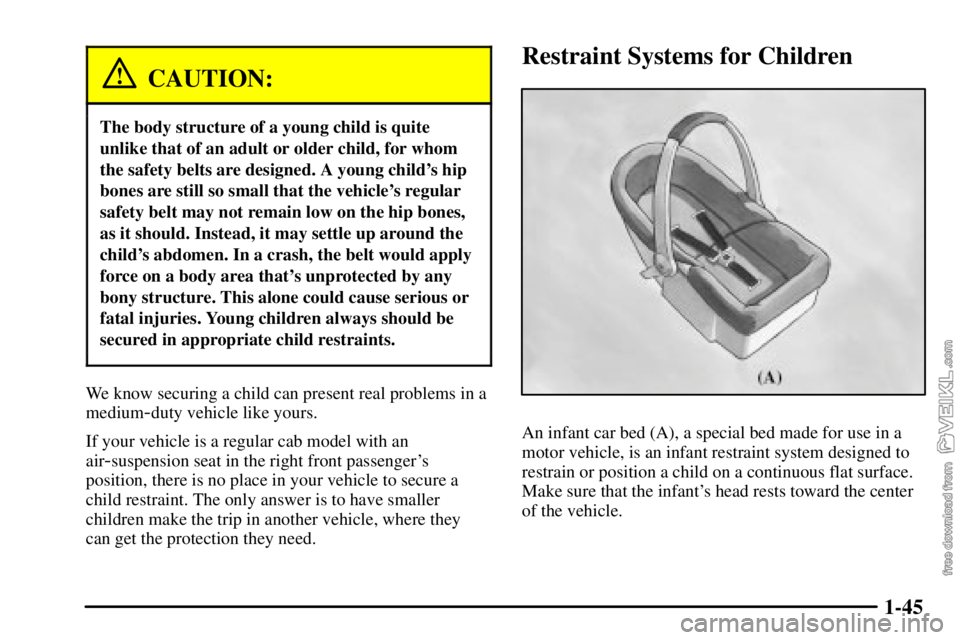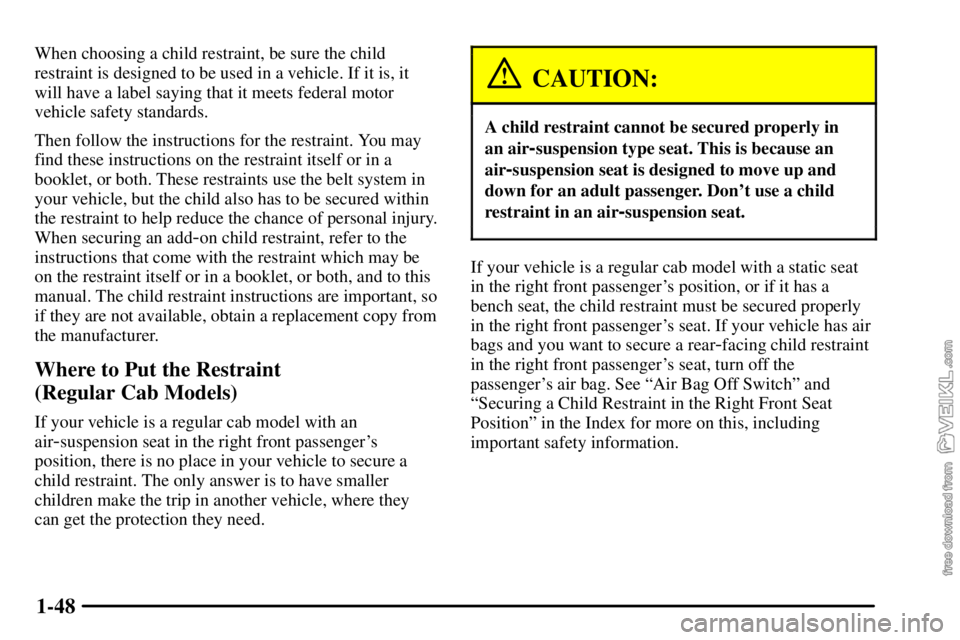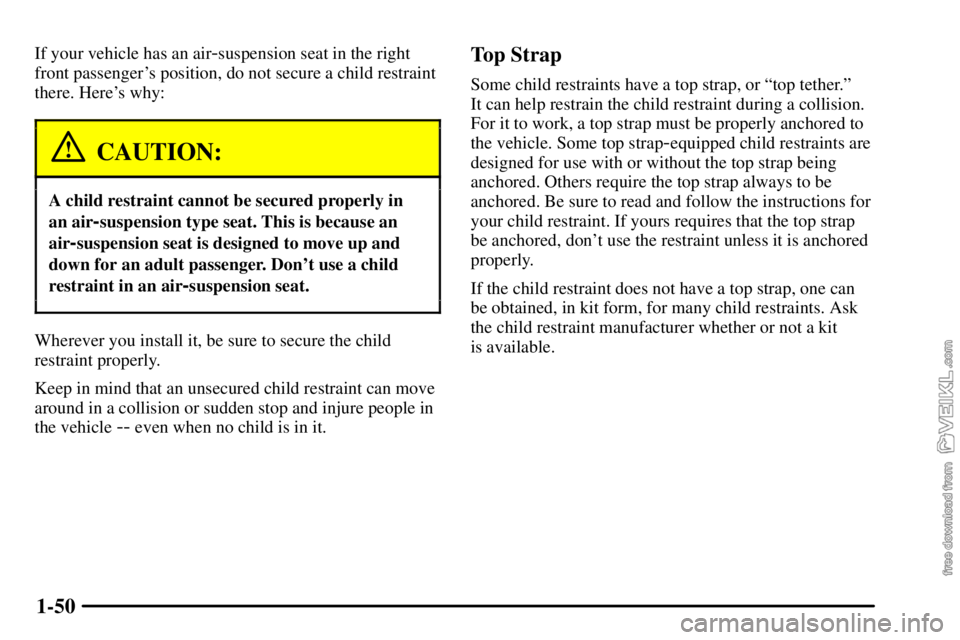Page 10 of 386
1-3 Split Bench Seat (If Equipped)
If your vehicle has a split bench seat, your seat is fixed
and is not able to be adjusted.
Air Suspension Seats (If Equipped)
If your vehicle has the low-back suspension seat, there
are six ways you can adjust the seat.
If your vehicle has the high
-back air suspension seat,
there are five ways you can adjust the seat.Height Adjustment
The suspension seat height
adjustment lever is located
on the front inboard side of
the seat.
To adjust the height of the air suspension seat, pull the
lever up to inflate. Push the lever down to deflate.
The seat cushion itself can also be raised or lowered.
Page 52 of 386

1-45
CAUTION:
The body structure of a young child is quite
unlike that of an adult or older child, for whom
the safety belts are designed. A young child's hip
bones are still so small that the vehicle's regular
safety belt may not remain low on the hip bones,
as it should. Instead, it may settle up around the
child's abdomen. In a crash, the belt would apply
force on a body area that's unprotected by any
bony structure. This alone could cause serious or
fatal injuries. Young children always should be
secured in appropriate child restraints.
We know securing a child can present real problems in a
medium
-duty vehicle like yours.
If your vehicle is a regular cab model with an
air
-suspension seat in the right front passenger's
position, there is no place in your vehicle to secure a
child restraint. The only answer is to have smaller
children make the trip in another vehicle, where they
can get the protection they need.
Restraint Systems for Children
An infant car bed (A), a special bed made for use in a
motor vehicle, is an infant restraint system designed to
restrain or position a child on a continuous flat surface.
Make sure that the infant's head rests toward the center
of the vehicle.
Page 55 of 386

1-48
When choosing a child restraint, be sure the child
restraint is designed to be used in a vehicle. If it is, it
will have a label saying that it meets federal motor
vehicle safety standards.
Then follow the instructions for the restraint. You may
find these instructions on the restraint itself or in a
booklet, or both. These restraints use the belt system in
your vehicle, but the child also has to be secured within
the restraint to help reduce the chance of personal injury.
When securing an add
-on child restraint, refer to the
instructions that come with the restraint which may be
on the restraint itself or in a booklet, or both, and to this
manual. The child restraint instructions are important, so
if they are not available, obtain a replacement copy from
the manufacturer.
Where to Put the Restraint
(Regular Cab Models)
If your vehicle is a regular cab model with an
air
-suspension seat in the right front passenger's
position, there is no place in your vehicle to secure a
child restraint. The only answer is to have smaller
children make the trip in another vehicle, where they
can get the protection they need.
CAUTION:
A child restraint cannot be secured properly in
an air
-suspension type seat. This is because an
air
-suspension seat is designed to move up and
down for an adult passenger. Don't use a child
restraint in an air
-suspension seat.
If your vehicle is a regular cab model with a static seat
in the right front passenger's position, or if it has a
bench seat, the child restraint must be secured properly
in the right front passenger's seat. If your vehicle has air
bags and you want to secure a rear
-facing child restraint
in the right front passenger's seat, turn off the
passenger's air bag. See ªAir Bag Off Switchº and
ªSecuring a Child Restraint in the Right Front Seat
Positionº in the Index for more on this, including
important safety information.
Page 57 of 386

1-50
If your vehicle has an air-suspension seat in the right
front passenger's position, do not secure a child restraint
there. Here's why:
CAUTION:
A child restraint cannot be secured properly in
an air
-suspension type seat. This is because an
air
-suspension seat is designed to move up and
down for an adult passenger. Don't use a child
restraint in an air
-suspension seat.
Wherever you install it, be sure to secure the child
restraint properly.
Keep in mind that an unsecured child restraint can move
around in a collision or sudden stop and injure people in
the vehicle
-- even when no child is in it.
Top Strap
Some child restraints have a top strap, or ªtop tether.º
It can help restrain the child restraint during a collision.
For it to work, a top strap must be properly anchored to
the vehicle. Some top strap
-equipped child restraints are
designed for use with or without the top strap being
anchored. Others require the top strap always to be
anchored. Be sure to read and follow the instructions for
your child restraint. If yours requires that the top strap
be anchored, don't use the restraint unless it is anchored
properly.
If the child restraint does not have a top strap, one can
be obtained, in kit form, for many child restraints. Ask
the child restraint manufacturer whether or not a kit
is available.
Page 65 of 386

1-58
5. To tighten the belt, pull its free end while you push
down on the child restraint. If you're using a
forward
-facing child restraint, you may find it
helpful to use your knee to push down on the child
restraint as you tighten the belt.
6. Push and pull the child restraint in different
directions to be sure it is secure.
To remove the child restraint, just unbuckle the vehicle's
safety belt. It will be ready to work for an adult or larger
child passenger.
Securing a Child Restraint in the Right
Front Seat Position
Although a rear seat is a safer place, you can secure a
forward
-facing child restraint in the right front seat, if it
is not an air suspension seat. Do not use a child restraint
with an air suspension seat.
If your vehicle has a right front passenger air bag,
there's a switch on the instrument panel that you can use
to turn off the right front passenger's air bag when you
want to secure a rear
-facing child restraint at the right
front passenger's position. See ªAir Bag Off Switchº in
the Index for more on this, including important safety
information.
Page 87 of 386
2-12
Switchbanks
Instrument Panel Switchbank
This switchbank is located in the center of the
instrument panel.
The switchbank may include marker lamp defeat, high
idle, traction control, heated mirrors, power take
-off,
rear air suspension, two
-speed axle (electric), exhaust
brake, two
-speed axle (air), differential lock, rear axle
differential lock and inter
-axle differential lock. If your
vehicle does not have some of the features controlled
by these switches, there will be a blank switch marker in
its place.
For more information, see each of these features in
the Index.
Page 108 of 386

2-33
On the highway, with the axle in low range and the
transmission in top gear, you may shift the axle to high
range by raising the switch and releasing the accelerator
momentarily. Reapply the accelerator after you shift.
Under light load conditions, first shift the axle into the
high range with the vehicle at a standstill and then
operate the transmission normally.
Air Shift Control (Automatic Transmission)
The switch for the rear axle
shift control is located in the
instrument panel
switchbank.
Press the bottom of the switch to get to the low range.
Press the top of the switch to return to the high range.The two
-speed axle should be in low when you park
the vehicle.
You'll need to engage the transmission, even moving the
vehicle a little, to be sure the axle is in low range. Then
shift into PARK (P), apply the parking brake and shut
off the engine.
Also, always start the vehicle in motion with the
two
-speed axle in the low position. To shift up from
low to high, press the top of the rear axle shift control
switch and press down on the accelerator. When you
shift the axle from high to low, press the bottom of the
switch, release the accelerator and then quickly press it
down again.
Air Suspension (If Equipped)
Your vehicle may be equipped with the Hendrickson
HAS Series single
-axle air suspension which is designed
for single
-axle on-highway use. The feature is available
in 19,000 lb. (8 618.3 kg), 21,000 lb. (9 525.4 kg) and
23,000 lb. (10 432.6 kg) capacities for operations which
require extra cubic capacity and a reduced deck height.
Page 109 of 386

2-34 Rear Air Suspension Dump Control
If your vehicle is equipped with the Hendrickson HAS
Series single
-axle air suspension, you have this control.
The air suspension dump control allows the operator to
lower the deck height approximately 4.5 inches
(11.5 cm) from the normal frame height.
The switch to deflate and
inflate the air suspension is
located in the instrument
panel switchbank.
Press the bottom of the switch to deflate the air
suspension and lower the deck height. Press the top
of the switch to return the suspension to normal
deck height.
An indicator light will come on and stay on whenever
the switch is in the dumped position.
Automatic Transmission Operation
We build vehicles with five and six-speed automatic
transmissions. This part of the manual covers the basics
of these. With some of the transmissions, you will find
another manual in your vehicle that goes into more
detail. On the headliner, in front of and above the driver,
or in some other place near the driver, you will see a
label that describes important operating facts about the
automatic transmission in your vehicle. Make sure you
follow the instructions on this label.
Be sure to keep your parking brake set until you are
ready to shift into DRIVE (D), and press the brake pedal
while shifting from NEUTRAL (N) or PARK (P) to a
drive gear.
All vehicles equipped with automatic transmissions
can be started in PARK (P), if equipped, or in
NEUTRAL (N). See the Allison
� Transmission
Operator's Manual in your vehicle for more information
about this.